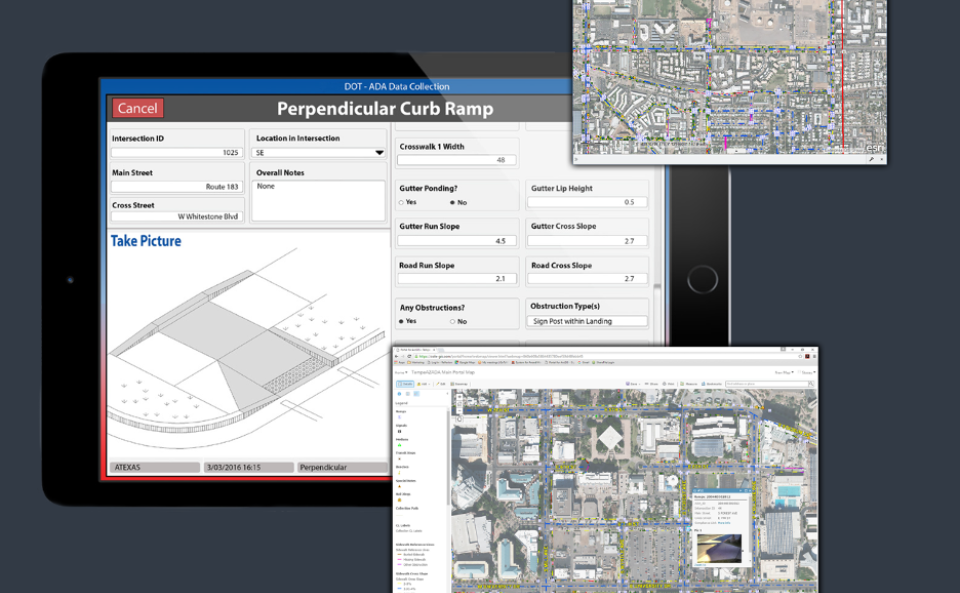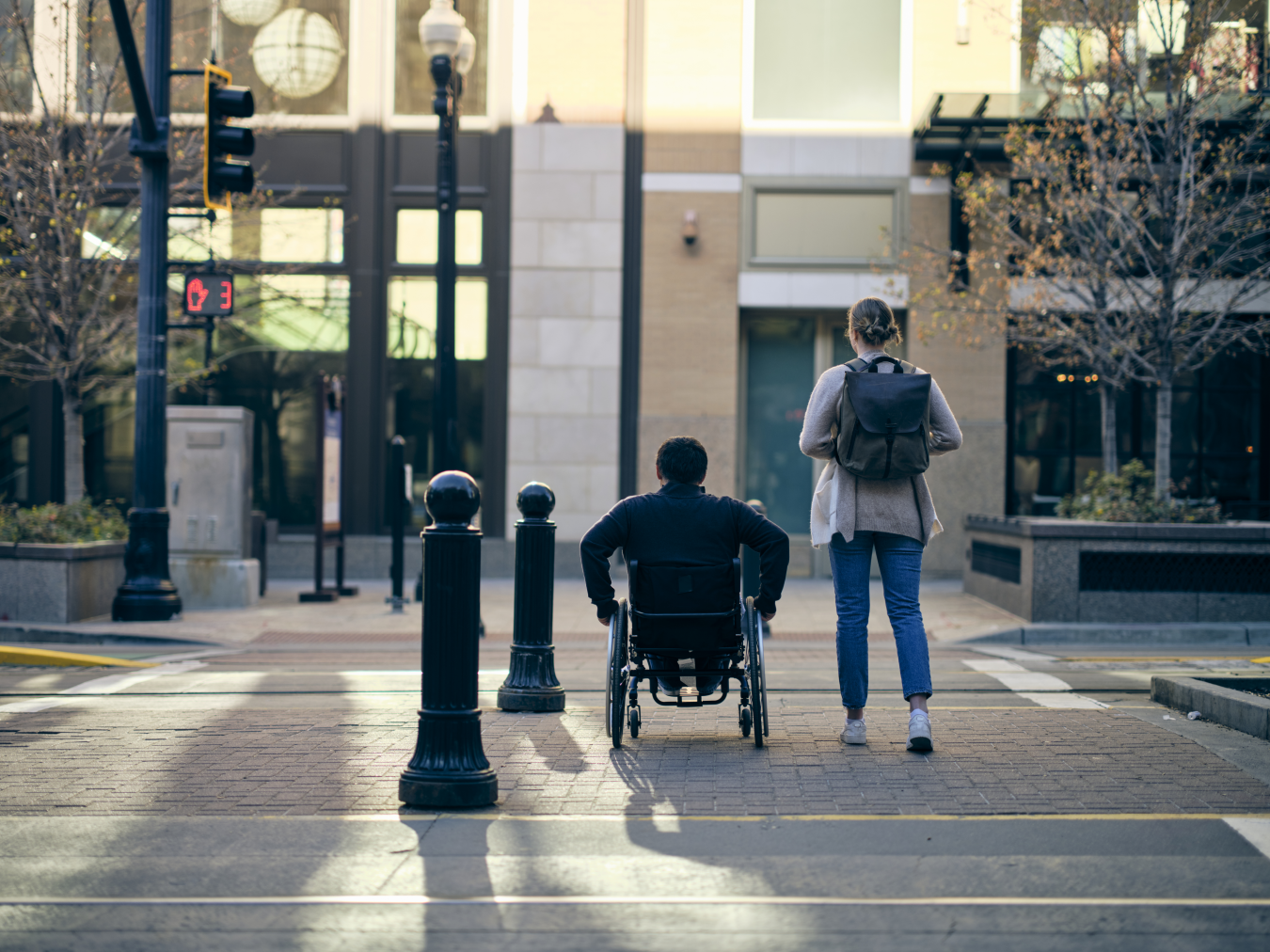Co Authored with: Ndemazea Fonkem, Federal Advocacy Intern at the National League of Cities
Note: The terms “disabled person” and “person with a disability” will be used interchangeably. Person-first and identity-first language both hold importance in the evolving discussions of disability, and it is often the person themselves who decides which language they prefer. Learn more about person-first and identity-first language here.
Walking is the second most common mode of transportation for Americans with disabilities, outpacing public transportation by a factor of four. Despite this, an average of 65 percent of curb ramps and 48 percent of sidewalks across the country were not fully accessible to those who struggle with mobility. However, cities are updating more infrastructure which includes accessibility updates, and also, realtors and developers are prioritizing accessibility using “walk scores” and other neighborhood amenities as ways to increase value in both urban and suburban neighborhoods by an average of 23.5 percent.
“This is the first step in ensuring all modes of transport – bus, bike, or walk – are designed with disabled people in mind.”
New Accessibility Guidance to Use
After several years of deep discussion and review, this August the U.S. Access Board published new public right-of-way guidelines (PROWAG) under the Americans with Disabilities Act (ADA) and the Architectural Barriers Act (ABA) to become more consistent with the latest technology and building methods to ensure inclusion for people with disabilities. The public right-of-way guidelines address access to sidewalks and streets, crosswalks, curb ramps, pedestrian signals, on-street parking and other components of public rights-of-way. And while all major U.S. cities have public transportation fleets that are fully wheelchair-accessible, this is the first step in ensuring all modes of transport – bus, bike, or walk – are designed with disabled people in mind.
City planners and city officials alike should familiarize themselves with the new public right-of-way guidelines standards to guarantee the inclusion of all abilities in new development. These guidelines review shared-use paths, which are designed primarily for use by bicyclists and pedestrians for transportation and recreation purposes. These guidelines inform federal, state, and local government agencies on how to make their pedestrian facilities, such as sidewalks, crosswalks, shared-use paths and on-street parking, accessible to people with disabilities. All local governments should be aware of the change and consider how new guidance can inform their upgrades.
The Access Board has released a new series of training videos here for local governments to use:
- Chapter 1: Application and Administration
- Chapter 2: Scoping Requirements
- Chapter 3: Technical Requirements
- Chapter 4: Supplemental Technical Requirements
- What’s New in the Final Rule Text
Additionally, in partnership with Great Lakes ADA Center, the Board will also provide a free webinar on the final rule on the public right-of-way accessibility guidelines
Watch on the You Tube channel (linked on the right) to view the webinar that took place on Thursday, October 5.
Accessibility Gains for Walking
The ADA was landmark legislation passed over 30 years ago ensuring legal protection against discrimination in public life against disabled people, and it continues to improve transportation accessibility as each individual project gets an update and becomes more accessible. However, some estimates of transportation infrastructure spending found that only 1 percent of spending is dedicated to walking facilities, despite 11 percent of trips in the U.S. being taken by foot. With demands for both pedestrian safety and walkable communities, increasing the share of trips walked or rolled must factor in those with disabilities and their access to cities, towns and villages. As Safe Street initiatives take off across the country, creating safe pedestrian walkways and walkable communities for all needs to put all needs and abilities at the forefront.
How Accessibility is Gaining in Tempe, AZ
In Tempe, AZ, the city worked to create an ADA Transition Plan, a comprehensive exploration of public spaces. From parks to crosswalks, the Tempe Planning Department alongside their Office of Strategic Management and Diversity identified barriers to accessibility, ranked them along a scale of severity, and from there were able to access partnerships with state and federal agencies to gain the funding for maintenance and development.
This transition plan is part of a larger conversation opened in Tempe about what it means to create accessible places. Mayor Corey Woods passed a proclamation on the 30th Anniversary of ADA’s passing, reaffirming the goals of the bill: equality of opportunity, full participation, economic self-sufficiency, and independent living for people with disabilities. With disabled Tempeans at the forefront, there is no surprise that Tempe ranks in the top five cities for individuals with disabilities to live.

Ask Any ADA Questions
The Access Board provides free technical assistance on accessibility guidelines and standards through its helpline at 1-202-272-0080, extension 3, and by email at ta@access-board.gov. For technical assistance specifically on accessibility of public right-of-way, including sidewalks, street crossings, and other pedestrian used features, email row@access-board.gov.
Additional Resources:
- NLC blog on universal design: https://www.nlc.org/article/2022/05/31/using-universal-design-to-create-safe-welcoming-and-joyful-spaces/
- Center for Excellence in Universal Design: https://universaldesign.ie/what-is-universal-design/the-7-principles/
- Transit equity: https://www.nlc.org/article/2022/09/01/increasing-transit-equity-through-partnership/
- Designing transit safety for Americans w/ disabilities: https://www.nlc.org/article/2022/03/29/designing-transit-safety-for-americans-with-disabilities/











